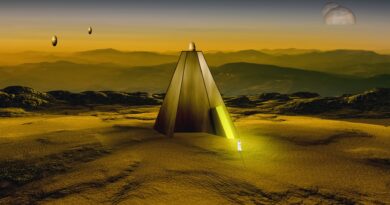Tower of Babel: The Inside Story
What Really Happened When the World was Divided 530 Years after Noah’s Flood.
By S. Douglas Woodward
A long-overlooked ancient event connected to the Tower of Babel story in the book of Genesis brings home to us that the Septuagint’s different chronology dramatically alters how we understand the meaning of key events in Genesis 1-11.
This event centers around single verse in Genesis 10, verse 25: “Peleg lived when the world was divided.” To cite it precisely, “To Eber were born two sons: the name of the one was Peleg, for in his days the earth was divided, and his brother’s name was Joktan.” (ESV)
But what does that mean? We read in the New English Translation of the Septuagint (the NETS’ LXX), the Greek Old Testament, “And to Eber were born two sons: the name of the one was Phalek, for in his days the earth was divided, and his brother’s name was Iektan.” (The NETS Bible uses more transliterated names from the Hebrew, preserving its Hebrew pronunciation, despite being an English version of the Greek translation.)
The more familiar names for the two boys were Peleg and Joktan as we read in the King James Version: “And unto Eber were born two sons: the name of one was Peleg; for in his days was the earth divided; and his brother’s name was Joktan.” Breton’s LXX (the classic nineteenth-century translation) translates it: “And to Heber were born two sons, the name of the one, Phaleg, because in his days the earth was divided, and the name of his brother Jektan.”
We will delve into the pivotal point a bit later, why the Hebrew Phalek or Bretton’s Phaleg, supplies more insight into the nature of the “dividing” that happened during these primeval times. But notice here how Eber is referenced as Heber. Many suggest that Heber presages the Hebrew people (a thousand years before Jacob aka Israel). Was Heber the father of Hebrews? Did he speak Hebrew?
Perhaps. Nonetheless, his name hints that what we call someone may tell us a great deal about them and ourselves. What’s in a name? As we will see, more than you might suppose.
One of the Most Mysterious Names in the Bible
At this point, allow me to introduce the meaning of the name Peleg and its associated word forms. There is much to know about this name, and we will acquire our education regarding it in several stages. Most scholars think it’s meaning is straightforward – but this is not true. When one researches the Dickins out of this verse as I have, you discover that the name Peleg is one of the most mysterious names in the Bible, whose meaning, when fully understood, has a significant bearing on how the primeval history of the Bible unfolds. It constitutes a peck of leaven in a mountain of dough.
With our first encounter regarding the issue of what the name Peleg means, let’s consider a new aspect of its sense rarely examined. Abarim’s Hebrew On-line Dictionary summarizes the name variations and their definitions with these words:
The root-verb (פלג palag) means to split or divide. This root appears to be mostly associated with canals (digging them or dividing lands with them), and the verb occurs a mere three times in the Bible: in Genesis 10:25, Job 38:25, and Psalm 55:9. This verb’s derivatives are:
· The masculine noun (פלג peleg), meaning channel or canal (Isaiah 30:25, Lamentations 3:48).
· The feminine noun (פלגה pelagga), meaning stream (Job 20:17) or division (Judges 5:15).
· The highly similar feminine noun (פלגה pelugga), meaning division (2 Chronicles 35:5 only).
· The feminine noun (מפלגה miplagga), also meaning division (2 Chronicles 35:12 only).
We will revisit the origin of the name further as we parse the differing interpretations of the name Peleg. But for now, take note of the connection between the word and water – not just any sort of splitting or dividing, but splitting or dividing with water as in a canal or channel or river.
The Division of the Nations: Three Views
There are three different views regarding the nature of the “division.”
The first view believes that the dividing which occurred during the time of Peleg relates to the Tower of Babel event, which caused the dispersion of “the nations” who had remained together in one place after the Flood. This view holds that the division means “to split up and scatter across the globe.” This is the majority viewpoint and the safest exegetically to defend. It sees the Hebrew word eretz referring to peoples, not to a landmass or the whole earth which is often represents instead.
The second view deals with a splitting up of a landmass. For those who subscribe to this view, eretz means land, earth, or world. In this case, we are dealing with the modern understanding from geology, to wit., plate tectonics, and what is known as continental drift. One of the principal issues here for those that ascribe to a division of the continents has to do with precisely when this occurred. Did it happen at the Flood? Did it begin at the Flood and continue gradually over an untold duration (perhaps 1,000 to 2,000 years)? Or did it happen many hundreds of years later, during the life of Peleg, according to the Septuagintal chronology (which would suggest its occurrence was at least 530 years after the Flood)?
The third view proposes a different concept altogether. In this third view, the continents had already separated eons before the Flood. The Flood mechanism, whatever it was causing an incalculable amount of water to appear suddenly on the globe, resulted in creating a new or more intense ice age after Noah’s Ark settled in the mountains of Ararat. This incredible amount of ocean water turned into ice, expanding (at least) the north polar ice cap, extending south into the area now Montana, North Dakota, and Minnesota. Plus, it deepened until it was several miles thick. But this icy phenomenon wouldn’t stay around forever. As the earth warmed, the ice began slowly melting into water, and sea level rose gradually and globally. In this scenario, hundreds of feet of what is underwater today were located on dry land then. Creation scientist Dr. John D. Morris provides his YEC perspective:

One “Separator” did occur sometime after the dispersion. The Ice Age, which followed the Flood, would have caused sea level to be an estimated 600 feet lower than today, since such a great volume of water was trapped as ice on the continents. Such a lowering of today’s seas would reconnect the continents once again. The connected continents would have aided in both animal and human migration following both the Flood and the dispersion, as commanded by God (Genesis 8:17; 11:4,8,9). Then the ending of the Ice Age and the melting of the ice sheets would cause sea level to rise, covering the land bridges and “dividing” the continents after migration had occurred.
In this scenario, rising sea levels hid an enormous number of human dwellings and artifacts that had been created during this 530-year-plus, post-Flood period. (People have always had a propensity to seek seashore property! A much broader Continental Shelf was just the ticket!) Since rising sea levels eliminated land bridges that had been created by the drastically lower sea levels, the dispersed peoples throughout the world were subsequently separated by water helping to keep them apart. Could this explanation be what was meant by the “division of the world”?
In this article, we have space to discuss only the first option in depth.

The Tower of Babel – Did Confusion Create Global Division?
The first view relies upon a most compelling origin: The Tower of Babel event. It caused divisions among the peoples of the world. Before Babel, all the world spoke one language. After Babel, it spoke many.
Unquestionably, this is the conventional view. The words of John Calvin (1509–1564), one of the pillars of the Protestant Reformation confirms this: “For after he [Moses] has mentioned Arphaxad as the third of the sons of Shem, he then names Peleg, his great-grandson, in whose days the languages were divided.”
Another famous commentator from the eighteenth century, John Gill (1697–1771) in his commentary entitled, Exposition of the Bible, stated the following: “For in his days was the earth divided among the three sons of Noah and their respective posterities; their language was divided, and that obliged them to divide and separate in bodies which understood one another; hence that age, ‘Peleg’ means ‘division,’ for he lived at the time when the earth was divided (niphlegah) and the name given to the man is in memory of this event. The event referred to must be the one under consideration—the Confusion of Tongues.”
Finally, the famed German theologians, Carl Friedrich Keil and Franz Delitzsch, voiced the same opinion 150 years ago: “Among the descendants of Arphaxad, Eber’s eldest son received the name of Peleg, because in his days the earth, i.e., the population of the earth was divided, in consequence of the building of the tower of Babel.”
The text of Genesis 10 teaches that 70 different language groups emerged, creating 70 different nations. Its recap of who these peoples were (and where they landed) comprise the “Table of Nations.” These are the distinctive peoples originating soon after the Flood through Noah’s three sons, Ham, Shem, and Japheth. “These are the clans of the sons of Noah, according to their genealogies, in their nations, and from these the nations spread abroad on the earth after the flood.” (Genesis 10:32, ESV) According to an article in Compelling Truth: “The Table of Nations is a list found in Genesis 10 that includes the list of the founders of 70 nations descended from Noah’s three sons Shem, Ham, and Japheth. The list includes 26 descendants of Shem, 30 descendants of Ham, and 14 descendants of Japheth.”
The verse following, Genesis 10:32, provides an interesting bit of color as well. We read the more literally translated words of the NETS Septuagint, “And the whole earth was one lip, and there was one speech for all.” (Genesis 11:1, NETS). One could create a play on words here (as I shamelessly and frequently practice to the embarrassment of my family) by pointing out that since the Tower of Babel event was next up, humanity was ready to “give God some lip.” The Bible continues, “And it came about as they moved from the east that they found a plain in the land of Sennar (Shinar) and settled there. And one person said to the next, “Come, let us make bricks and bake them with fire.” And they said, ‘Come, let us build ourselves a city and a tower whose top shall be as far as heaven, and let us make a name for ourselves before we are scattered abroad upon the face of the whole earth.” (Genesis 11:1-4, NETS) Of course, the Lord God was soon to pay them a visit and bring down the house – or tower in their case. His action of destroying the Tower of Babel and confusing the languages led immediately to the outcome the humans feared – dispersing across the globe. This eventuality was disastrous from their perspective. They wanted to stay together to make a name for themselves. Perhaps they thought, “There is strength in numbers. If we stay together, we can overcome the gods (elohim) and grow to be equal to them.” But the God whom they feared the most would have none of it. The rebels wanted to be as gods (sound familiar?). But God put them in their place (actually in multiple places).

There are other lessons here about cities multiplying sins (“the bigger the city, the ‘badder’ the people get”). But that “moral of the story” will be saved for another time. The conventional view – which is the safest way to see what happens through the chaos soon to ensue – is that God caused everyone to babble about, by confusing their tongues or speech (their “lip”).

Babel: Confusion or Stargate?
No doubt about it: The most common of all perspectives is that the Tower of Babel meant the Tower of Confusion. Babel means confusion (although it also can mean “stargate” or something close to it). And when we hear that, we immediately think babble implies speaking nonsense syllables.
Assuming this was the case, then, predictably, the people lost their common cause and went separate ways after locating comrades who spoke the same way they did. Furthermore, driving them apart was a newly ingrained fear: Suspicion. As the confusion abated, suspicious minds led them to vacate the premises, putting distance between themselves and those whose words were indecipherable. After all, the denizens of Shinar weren’t all that different from modern humans. Our primal misgiving teaches us that those we don’t understand must be saying bad things about us – and planning to do us harm. Language distinctions naturally lead to division. Therefore, perhaps the most obvious option is the right option. Occam’s Razor usually applies.
Drs. John Morris and Jim Johnson, in their July 2009 paper, favoring a geological explanation for the meaning of “division,” acknowledge that the traditional view connects the division of the world with the confusion of languages at the Tower. They quote scholar David Fouts:
The traditional understanding of Genesis 10:25 has been that the etiological notice appearing with Peleg’s name (“for in his days the earth was divided [niplega]” is a literary foreshadowing of the division of languages in the account of the tower of Babel (chap.11) and/or that it also may serve to demonstrate a division of Eber’s line into the ancestors of Abraham on the one hand and the builders of Babylon on the other. Those who support a traditional view include Keil and Delitzsch, Morris and Whitcomb, G.C. Aalders, H.C. Leupoid, Allen Ross, John Sailhamer, Victor Hamilton, Richard T. White, and Jewish sources.
In a 2014 edition of the magazine Bible and Spade, Rick Lanser, MDiv, refreshed his earlier viewpoint from 2009. He summarized the traditional view, noting that it relies upon “context” to ground its position. YEC adherents, he asserts:
· First, … view the verb palag, typically rendered “divided” in Gen. 10:25, as essentially synonymous with two other verbs, parad and puwtz, that come up several times in Genesis 10 and 11.
· Second, they hold that the Hebrew word eretz in Genesis 10:25 is a metaphor for “people” rather than carrying its usual non-figurative meaning of “earth” or “land.” Thus, they say Genesis 10:25 should be paraphrased, “the name of the one was Peleg, because in his day the people were divided by their languages.”
· Finally, they view all the information in Genesis 10 and the Babel account of Genesis 11 as a contextual unit, such that information from one chapter influences the interpretation of the other.
Lanser tells us that we can make too much of context, and that is what happens here. More on Lanser later, but first, let’s discuss his point that “context” isn’t the overriding factor determining what Peleg and the variations of his name mean. And let’s consider another example that confirms his exegetical commentary. Lanser believes the comment about the divisions in Peleg’s day is a parenthetical comment in the same vein (although shorter) as the digression made about Nimrod. Recall Genesis 10:6-9, where we read about the Bible’s first bigger-than-life anti-hero:
The sons of Ham: Cush, Egypt (Mizraim), Put, and Canaan. The sons of Cush: Seba, Havilah, Sabtah, Raamah, and Sabteca. The sons of Raamah, Sheba and Dedan. Cush fathered Nimrod; he was the first on earth to be a mighty man. He was a mighty hunter before the LORD. Therefore, it is said, “Like Nimrod, a mighty hunter before the LORD.” (ESV)
Why did the author list the sons of Cush, but identified Nimrod separately rather than in the list of Cush’s sons? Was it that he was just a grandson and not a son? Something was distinctly different from him. Following in verses 10-12, are the cities that Nimrod built in the land of Shinar (the area where the rebels had built Babel). The table of nations identifies only Nimrod as a city builder. As tradition teaches, this designation could suggest he had attempted to create the first skyscraper.
And it is essential to note that the verb for divide inferred in Peleg’s name (palag), is not the same word used in Genesis 10:32 for division (parad). In fact, while the King James translates it “divided,” the New American Standard Bible equates the word with “separation,” and the English Standard Version provides a more elaborate definition, “spread abroad.” Parad is the word used in Genesis 10:5, “From these the coastland peoples spread in their lands, each with his own language, by their clans, in their nations.” (ESV) Therefore, division can mean “to become separated” or “to be spread out.” However, Larry Pierce, another Young Earth Creationist, makes this assertion in support of the conventional view:

The traditional interpretation, which seems more reasonable, relates this verse to the division of people/nations at the Tower of Babel event in Genesis 11. (Just like the English “earth” can have a variety of meanings, the Hebrew erets can also mean nation(s)—thus erets Yisrael, the land [nation, people] of Israel.) According to the biblical chronology as deduced by Archbishop Ussher, the Flood occurred in 2349–2348 BC, and Peleg was born in 2247 BC about a hundred years later.
Peleg, from the MT chronology, was born only 100 years after the Flood, therefore, at the same time as the Tower of Babel – hence division means “language confusion.” Pierce cites numerous sources writing hundreds of years after Christ, who support the conventional view, referencing Peleg, and commenting that he lived very near to the Flood.
One source, Manetho writing in the third century B.C. (from whom academicians base much of Egyptian history) stated that the Tower of Babel occurred five years after the birth of Peleg (instead of 530 years before as I believe the LXX teaches). According to Pierce, another source, the Byzantine chronicler Constantinus Manasses (d. 1187) wrote almost 1,150 years after Christ “that the Egyptian state lasted 1,663 years. If correct, then counting backward from the time that Cambyses, king of Persia, conquered Egypt in 526 BC, gives us the year of 2,188 B.C. for the founding of Egypt, about 60 years after the birth of Peleg.” Therefore, MT chronology conflicts with the Egyptian timeline by 1,000 years!

In other words, Pierce’s position, driven by the Ussher dating system, argues the founding of Egypt was almost 1,000 years later than what academic historians maintain. This global cadre includes not just Egyptologists but virtually everyone who studies ancient history. To be precise in this miscalculation, 2,188 B.C. is the beginning of Egyptian dynasties, instead of 3,100 B.C. To assert this point of view is nothing short of outrageous. Indeed, this position constitutes one of the greatest anti-apologetics for biblical history. It is impossible to reconcile these dates – unless we can prove that Egyptologists are off by a whole millennium! Therefore, it’s the ultimate damaging argument for Creationists who dutifully rely on the chronology of the Masoretic Text and who hope to underscore that the Bible teaches true history. (As stated earlier, it’s “Ignorance emboldened by tradition.”)
This Strengthens the Creationists’ Argument
Nonetheless, for Pierce, the Septuagint is just “silly” (and its chronology since it’s highly divergent from the MT), should be discounted entirely. As I have said in other places, the connection between the authority of scripture, the King James Bible, and the Ussher chronology are all tightly coupled to Young Earth Creationism. My plea to them: Adopting the LXX chronology strengthens your argument! The MT chronology constitutes your Achilles heel! This linkage between the YEC, the King James Bible, and the MT, isn’t mandated just because Fundamentalists tie scriptural authority to the King James Version of 1611. One can argue for scriptural authority and still be reliant upon the what the rabbis called “The Christian Bible” aka the LXX, especially if we grasp the chronology of the Masoretic (and thus, the King James Version) was corrupted by first-century rabbis to obscure that Jesus was the Messiah.
Moreover, one can argue for YEC and uphold the LXX chronology. This acknowledgment is one of the primary lessons I hope the reader will take to heart.


S. Douglas Woodward, Th.M., MA in Finance, has served as an executive for Oracle, Microsoft, and as a Partner at Ernst & Young LLP. He was recently an Adjunct Professor and Entrepreneur-in-Residence at the University of Oklahoma for five years. Doug has written eighteen books on the topics of eschatology, theology, and geopolitics. He frequently appears on radio and television programs, having been interviewed on over 100 different occasions on dozens of shows. He has two children, two grandchildren, and lives with wife Donna of 45 years in Oklahoma City. Learn more at www.faith-happens.com.



